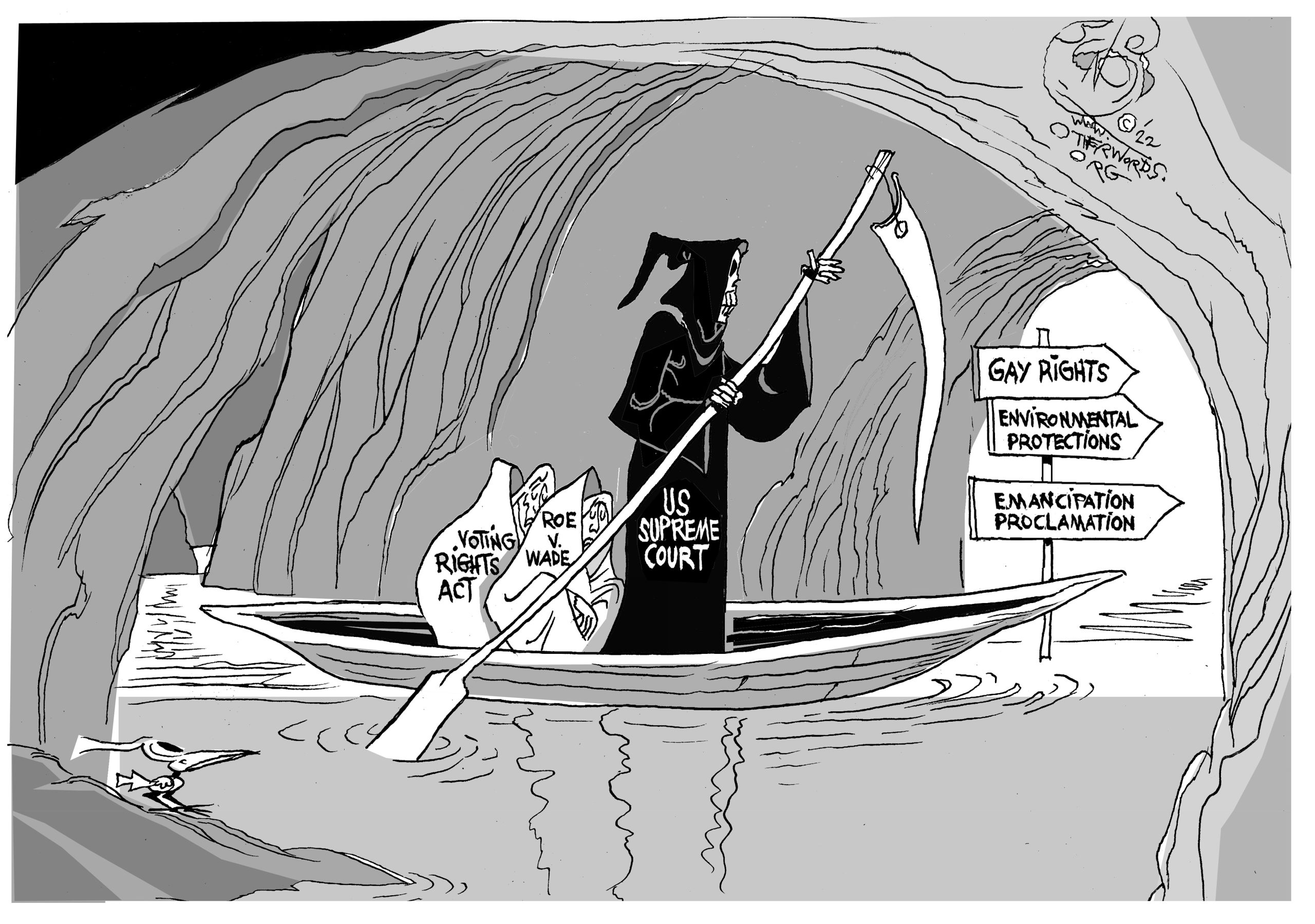
Do Fear the Reaper. An OtherWords cartoon by Khalil Bendib
Women, girls, and all people who can become pregnant need abortions. Before abortion was legalized in the US, almost a million women a year sought illegal abortions. According to the Centers for Disease Control tens of millions of women, girls, and other persons have had abortions since Roe v. Wade legalized them in 1973—one in four women. The peak years for legal abortions (1.5 million annually) were 1975 to 2006, before a cascade of state restrictions made this medical procedure more and more difficult to get.
What I have to say about the US Supreme Court decision (Dobbs v/ Jackson Women’s Health Organization) ending women’s Constitutional right to an abortion by allowing states to prohibit and criminalize it will seem radical to some and reactionary to others. Radical because it includes a critique of the way heterosexual sex is performed and fetishized in patriarchal societies. Reactionary because it includes a critique of the way heterosexual sex is performed and fetishized in patriarchal societies. The act that causes pregnancy is rarely subjected to critical scrutiny.
The men responsible for ending our right to an abortion have little concern or knowledge of what being pregnant and nurturing a fetus inside one’s body involves. Nor what it feels like to give up the being your body has supported for nine months. Nor what it is like to have a child you can’t afford or don’t want. Nor how another child will impact the children you have. The men who caused this catastrophe, along with their female allies, are callous and cruel to women, girls, and other people who can get pregnant.
Feminists and others who care about women’s equality and well-being worked for much of the twentieth century to make birth control legal (spurring the landmark 1965 decision Griswold v. Connecticut) and available. They also struggled for decades for the right to a safe and legal abortion—first state by state and then nationally, culminating in the six-to-three Roe decision. I am a feminist and have been since my teens. Yet, I was not involved in either struggle. I did benefit from them and knew that I did.
Having been born with a body that could get pregnant, I began in 1962 taking one of the earliest oral contraceptives: the pill. It was a 10 mg estrogen/progesterone bomb. I say “bomb” because of the health dangers posed by large infusions of hormones. Over the 11 years I was married and engaged in penis-in-vagina intercourse with a person who ejaculated spermatozoa, I continued the pill. It gradually shrank from 10 mg to 5 mg to 1 mg to 0.05 mg of the hormones. Thank you, Planned Parenthoods of Champaign and Austin for the reproductive health care you provided.
In 1973, I came out as a lesbian. Although I no longer needed contraception, I knew that if I were raped I could get an abortion, thanks to the Roe decision. For me and millions of women and girls—girls who menstruate and can get pregnant—our sense of security was short-lived. The anti-abortion movement was already attacking the rights so recently won. Feminists and others who cared about women/girls/persons organized a resistance movement to oppose the relentless attempts to restrict and eliminate abortion access in the US.
First, in 1976 Congress passed the Hyde Amendment. It barred the use of federal funds (Medicaid, Medicare, and all other federal health care plans) to pay for abortion, except when the life of the woman was in danger. Before the amendment went into effect in 1980, about 300,000 abortions a year were federally funded. The US Supreme Court upheld the amendment in a 1980 decision (Harris v. McRae).
Simultaneously, a series of state laws—a trickle that became a tsunami—began restricting abortion. The first state statutes required pregnant minors to obtain parental consent for the procedure. The US Supreme Court upheld these laws in 1979 (Belloti v. Baird), but allowed teens to petition for judicial hearings in place of parental consent. The opponents of legal abortion were determined. Next came state legislation requiring spousal consent; waiting periods of various lengths; and Targeted Regulation of Abortion Provider laws designed to limit the number of clinics in a state and thus the availability of abortion.
Added to these burdens were state laws requiring an ultrasound before the procedure and presentations by anti-abortion counselors, and denying state Medicaid funds for abortion. The 1992 US Supreme Court decision Planned Parenthood of Southeastern Pennsylvania v. Casey upheld these restrictions and opened the floodgates for more and more laws narrowing access to a medically necessary procedure. It is the Casey decision that ended the unfettered right to have an abortion in the first three months of pregnancy established by Roe. By allowing states to regulate abortion during the previously sacrosanct first trimester of pregnancy, state legislatures drastically shortened access to the procedure from the 24 to 28 weeks authorized by Roe.
Since the Dobbs decision on June 24, 2022, nine states have legally banned and criminalized abortions; four ban them after six weeks; one state at 15 weeks; and nine states at 22 or 20. Women will die, while men will suffer very little and only indirectly from this decision.
I am ashamed that I did not work harder for abortion rights. What I have done is attend countless demonstrations, rallies, marches, and vigils during the past 46 years. What I have done is organize an abortion rights organization—Action for Reproductive Freedom—with a co-worker in Champaign-Urbana in 1990 to oppose these state restrictions. What I have done is confront men protesting outside abortion clinics with a demand, “Please stop fucking women.”
Which brings me to my critique of the act which leads to pregnancy: penis-in-vagina intercourse. It is no exaggeration to say that this act defines heterosexual sex and IS sex in most patriarchal societies. I own that my lesbian perspective biases me. But mountains of research on sexuality confirm my bias. In study after study a majority of women in heterosexual relationships report that they prefer kissing, cuddling, mutual masturbation, focused clitoral stimulation (not the imaginary stimulation that comes from penile pumping) and oral sex to the intercourse prescribed in heterosexual relations. Many women report engaging in intercourse because it is expected, demanded—to please male partners but NOT themselves.
It should be obvious that humans can have intimacy AND orgasms in more woman-centered, less dangerous ways. Dangerous because of possible pregnancy but also increased gynecological visits for sexually transmitted diseases (STDs) and vaginal infections. As a C-U gynecologist told me, “STDs are not equal-opportunity infections. The physics of intercourse (friction plus ejaculation) means that women are infected by men more than vice versa, and the infections are more severe.” Of course women who prefer this act as their primary sexual expression will continue it. What I am suggesting is that women take charge in heterosexual relations and demand the sexual acts that are safest and most pleasurable to them. If they do, some unplanned pregnancies might be avoided. Even so, women/girls/persons who can get pregnant will always need abortions. We must fight like hell to restore and expand the abortion rights we won in 1973.

Mary Lee Sargent lived in Champaign-Urbana from 1966 to 2003. She taught US History and US Women’s History at Parkland College and was active in the feminist, LGBT rights, civil rights and anti-war movements. She lives and works in New Hampshire.
1,113 total views, 2 views today
